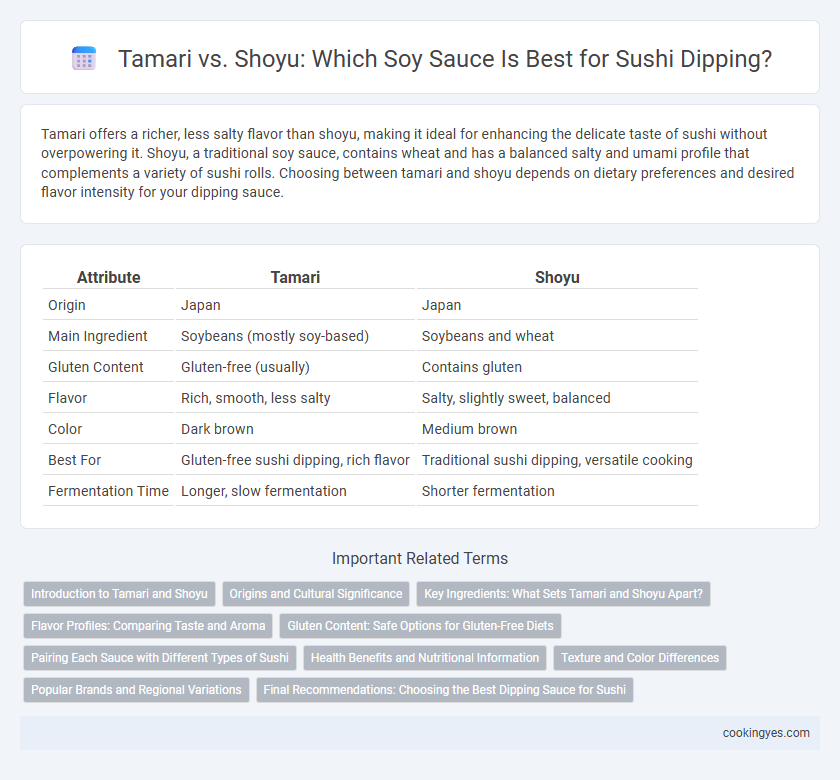Tamari offers a richer, less salty flavor than shoyu, making it ideal for enhancing the delicate taste of sushi without overpowering it. Shoyu, a traditional soy sauce, contains wheat and has a balanced salty and umami profile that complements a variety of sushi rolls. Choosing between tamari and shoyu depends on dietary preferences and desired flavor intensity for your dipping sauce.
Table of Comparison
| Attribute | Tamari | Shoyu |
|---|---|---|
| Origin | Japan | Japan |
| Main Ingredient | Soybeans (mostly soy-based) | Soybeans and wheat |
| Gluten Content | Gluten-free (usually) | Contains gluten |
| Flavor | Rich, smooth, less salty | Salty, slightly sweet, balanced |
| Color | Dark brown | Medium brown |
| Best For | Gluten-free sushi dipping, rich flavor | Traditional sushi dipping, versatile cooking |
| Fermentation Time | Longer, slow fermentation | Shorter fermentation |
Introduction to Tamari and Shoyu
Tamari and Shoyu are traditional Japanese soy sauces commonly used for dipping sushi, each with distinct flavors and ingredients. Tamari is typically gluten-free and made primarily from fermented soybeans, offering a richer, less salty taste. Shoyu combines soybeans and wheat, resulting in a balanced, slightly sweet soy sauce that complements a variety of sushi styles.
Origins and Cultural Significance
Tamari, originating from Japan's Kanto region, is a thicker, richer soy sauce traditionally made as a byproduct of miso fermentation, widely prized for its gluten-free properties and deep umami flavor. Shoyu, with roots in China's ancient soy sauce-making methods, was adapted in Japan and has become the most common soy sauce, known for its balanced, lighter taste with a mix of soy and wheat. Both sauces hold significant cultural value in Japanese cuisine, with Tamari often preferred in traditional sushi establishments for its intense flavor that complements delicate fish, while Shoyu remains a versatile staple for general dipping and seasoning.
Key Ingredients: What Sets Tamari and Shoyu Apart?
Tamari is a gluten-free soy sauce made primarily from soybeans with little to no wheat, resulting in a richer, thicker, and less salty flavor ideal for dipping sushi. Shoyu, a traditional Japanese soy sauce, combines soybeans and wheat, offering a balanced salty-sweet profile with a lighter consistency. The key ingredient difference--wheat content--defines tamari's bold umami taste versus shoyu's subtle, nuanced flavor, influencing their use in sushi dipping sauces.
Flavor Profiles: Comparing Taste and Aroma
Tamari features a richer, less salty flavor with a smooth, umami-packed profile and a subtle sweetness, making it ideal for enhancing sushi without overpowering the fish's delicate taste. Shoyu offers a brighter, saltier flavor with a complex aroma derived from a blend of soybeans and wheat, providing a slightly tangy and savory complement to sushi. Both dipping sauces add distinct layers of taste, where tamari emphasizes depth and smoothness, and shoyu highlights balance and aromatic sharpness.
Gluten Content: Safe Options for Gluten-Free Diets
Tamari is a gluten-free soy sauce made primarily from fermented soybeans without wheat, making it a safe dipping sauce option for individuals with gluten sensitivities or celiac disease. Shoyu typically contains wheat, which introduces gluten and may trigger adverse reactions in gluten-intolerant consumers. Choosing tamari ensures flavorful sushi accompaniment while adhering to strict gluten-free dietary requirements.
Pairing Each Sauce with Different Types of Sushi
Tamari, with its rich, less salty flavor and gluten-free profile, pairs exceptionally well with delicate sushi like sashimi and nigiri, enhancing natural fish flavors without overpowering them. Shoyu, a traditional soy sauce with a balanced salty and umami taste, complements heartier sushi types such as maki rolls and tempura rolls by adding depth and complexity. Choosing between Tamari and Shoyu depends on the sushi variety, with Tamari best suited for pure, fresh fish and Shoyu ideal for sushi with robust ingredients and flavors.
Health Benefits and Nutritional Information
Tamari offers a gluten-free alternative to traditional shoyu, making it suitable for those with gluten sensitivities or celiac disease, while providing a richer, less salty flavor. It contains slightly higher protein levels and is often lower in sodium compared to regular shoyu, contributing to heart health and reduced blood pressure risks. Shoyu, a fermented soy sauce made with wheat, delivers antioxidants and beneficial enzymes but may contain more sodium and gluten, influencing dietary restrictions and overall sodium intake.
Texture and Color Differences
Tamari presents a thicker, smoother texture compared to the thinner consistency of traditional shoyu, enhancing its cling to sushi. The deep, dark amber hue of tamari contrasts with the lighter, reddish-brown shade characteristic of shoyu, influencing the visual appeal when serving sushi. These textural and color differences highlight tamari's suitability for richer flavor profiles, while shoyu offers a more delicate touch to complement various sushi types.
Popular Brands and Regional Variations
Tamari and Shoyu are both popular soy sauce varieties used as dipping sauces for sushi, with Kikkoman and Yamasa leading the market for Shoyu, while San-J dominates Tamari production. Tamari, originating from Japan's Chubu region, is gluten-free and has a richer, less salty flavor compared to Shoyu, which is widely produced in the Kanto region and contains wheat. Regional preferences influence usage, with Tamari favored in Western Japan and among those seeking gluten-free options, whereas Shoyu remains the classic choice in Eastern Japan and globally.
Final Recommendations: Choosing the Best Dipping Sauce for Sushi
Tamari offers a richer, gluten-free option with a smoother, less salty flavor, making it ideal for those with dietary restrictions or who prefer a milder taste. Shoyu, a traditional soy sauce with a balanced salty and umami profile, complements a variety of sushi types, providing a classic dipping experience. For sushi enthusiasts seeking authenticity, Shoyu is often preferred, while Tamari suits those looking for a subtler, gluten-free alternative.
Tamari vs Shoyu for dipping sauces Infographic

 cookingyes.com
cookingyes.com